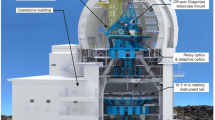Abstract
Long-exposure spectro-polarimetry in the near-infrared is a preferred method to measure the magnetic field and other physical properties of solar prominences. In the past, it has been very difficult to observe prominences in this way with sufficient spatial resolution to fully understand their dynamical properties. Solar prominences contain highly transient structures, visible only at small spatial scales; hence they must be observed at sub-arcsecond resolution, with a high temporal cadence. An adaptive optics (AO) system capable of directly locking on to prominence structure away from the solar limb has the potential to allow for diffraction-limited spectro-polarimetry of solar prominences. We show the performance of the off-limb AO system and its expected performance at the desired science wavelength Ca ii 8542 Å.













Similar content being viewed by others
References
Berger, T.: 2014, Solar prominence fine structure and dynamics. In: Schmieder, B., Malherbe, J.M., Wu, S.T. (eds.) Nature of Prominences and Their Role in Space Weather, IAU Symp. 300, 15.
Berger, T., Testa, P., Hillier, A., Boerner, P., Low, B.C., Shibata, K., Schrijver, C., Tarbell, T., Title, A.: 2011, Magneto-thermal convection in solar prominences. Nature 472, 197.
Berkefeld, T., Schmidt, D., Soltau, D., von der Lühe, O., Heidecke, F.: 2012, The GREGOR adaptive optics system. Astron. Nachr. 333, 863.
Berry, R., Burnell, J.: 2000, The Handbook of Astronomical Image Processing 1st. edn. Willmann-Bell, Inc., Richmond, 193.
Born, M., Wolf, E.: 1999, Principles of Optics, 7th edn. Cambridge University Press, Cambridge, 528.
Cavallini, F.: 2006, IBIS: A new post-focus instrument for solar imaging spectroscopy. Solar Phys. 236, 415.
Chen, P.F.: 2011, Coronal mass ejections: models and their observational basis. Living Rev. Solar Phys. 8(1). http://solarphysics.livingreviews.org/Articles/lrsp-2011-1/ .
Dai, G.M.: 1995, Modal compensation of atmospheric turbulence with the use of Zernike polynomials and Karhunen–Loeve functions. J. Opt. Soc. Am. 12, 2182.
Fried, D.L.: 1965, Statistics of a geometric representation of wavefront distortion. J. Opt. Soc. Am. 55, 1427.
Hardy, J.: 1998, Adaptive Optics for Astronomical Telescopes, Oxford Univ. Press, New York, 115, 308.
Jaeggli, S.A., Lin, H., Mickey, D.L., Kuhn, J.R., Hegwer, S.L., Rimmele, T.R., Penn, M.J.: 2010, FIRS: A new instrument for photospheric and chromospheric studies at the DST. Mem. Soc. Astron. Ital. 81, 763.
Labrosse, N., Heinzel, P., Vial, J.C., Kucera, T., Parenti, S., Gunár, S., Schmieder, B., Kilper, G.: 2010, Physics of solar prominences: I-Spectral diagnostics and non-LTE modelling. Space Sci. Rev. 151, 243.
Lukin, V.P., Fortes, B.V.: 1998, Partial correction for turbulent distortions in telescopes. Appl. Opt. 37, 4561.
MacKay, D.H., Karpen, J.T., Ballester, J.L., Schmieder, B., Aulanier, G.: 2010, Physics of solar prominences: II-Magnetic structure and dynamics. Space Sci. Rev. 151, 333.
Marino, J.: 2007, Long exposure point spread function estimation from solar adaptive optics loop data. Ph.D. thesis. New Jersey Institute of Technology and Rutgers The State University of New Jersey – Newark.
Michau, V., Rousset, G., Fontanella, J.: 1993, Wavefront sensing from extended sources. In: Radick, R.R. (ed.) Real Time and Post Facto Solar Image Correction, Proc. 13th Sacramento Peak Summer Workshop, National Solar Observatory, 124.
Noll, R.J.: 1976, Zernike polynomials and atmospheric turbulence. J. Opt. Soc. Am. 66, 207.
Orozco Suárez, D., Asensio Ramos, A., Trujillo Bueno, J.: 2013, Measuring vector magnetic fields in solar prominences. In: Guirado, J.C., Lara, L.M., Quilis, V., Gorgas, J. (eds.) Highlights of Spanish Astrophysics VII, Spanish Astronomical Society, New Mexico, 786.
Rimmele, T., Berger, T., Casini, R., Elmore, D., Kuhn, J., Lin, H., Schmidt, W., Wöger, F.: 2014, Prominence science with ATST instrumentation. In: Schmieder, B., Malherbe, J.M., Wu, S.T. (eds.) Nature of Prominences and Their Role in Space Weather. IAU Symp. 300, 362.
Rimmele, T.R., Marino, J.: 2011, Solar adaptive optics. Living Rev. Solar Phys. 8(2). http://solarphysics.livingreviews.org/Articles/lrsp-2011-2/ .
Rimmele, T.R., Radick, R.R.: 1998, Solar adaptive optics at the National Solar Observatory. In: Adaptive Optical System Technologies, Proc. SPIE 3353, 72.
Roddier, F. (ed.): 1999, Adaptive Optics in Astronomy, Cambridge Univ. Press, London.
Scharmer, G.B., Dettori, P.M., Lofdahl, M.G., Shand, M.: 2003, Adaptive optics system for the new Swedish solar telescope. In: Keil, S.L., Avakyan, S.V. (eds.) Innovative Telescope and Instrumentation for Solar Astrophysics, Proc. SPIE 4853, 370.
Tandberg-Hanssen, E.: 1995, The Nature of Solar Prominences. Kluwer Academic Publishers, Dordrecht.
Taylor, G.E., Rimmele, T.R., Marino, J., McAteer, R.T.J.: 2013, An off-limb solar adaptive optics system: Design and testing. In: Fineschi, S., Fennelly, J. (eds.) Solar Physics and Space Weather Instrumentation V, Proc. SPIE 8862, 88620C.
Taylor, G.E., Rimmele, T.R., Marino, J., Tritschler, A., McAteer, R.T.J.: 2012, Solar limb adaptive optics: A test of wavefront sensors and algorithms. In: Rimmele, T.R., Tritschler, A., Wöger, F., Collados Vera, M., Socas-Navarro, H., Schlichenmaier, R., Carlsson, M., Berger, T., Cadavid, A., Gilbert, P.R., Goode, P.R., Knölker, M. (eds.) Second ATST-EAST Meeting: Magnetic Fields from the Photosphere to the Corona., ASP Conf. Ser. 463, 321.
Welch, P.D.: 1967, The use of fast Fourier transform for the estimation of power spectra: A method based on time averaging over short, modified periodograms. IEEE Trans. Audio Electroacoust. 15, 70.
Author information
Authors and Affiliations
Corresponding author
Rights and permissions
About this article
Cite this article
Taylor, G.E., Schmidt, D., Marino, J. et al. Performance Testing of an Off-Limb Solar Adaptive Optics System. Sol Phys 290, 1871–1887 (2015). https://doi.org/10.1007/s11207-015-0697-9
Received:
Accepted:
Published:
Issue Date:
DOI: https://doi.org/10.1007/s11207-015-0697-9




